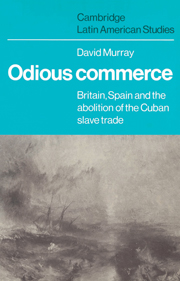Book contents
- Frontmatter
- Contents
- Tables
- Preface
- 1 The ‘opening’ of a legal trade
- 2 Parliament versus Cortes
- 3 Legality and illegality
- 4 The treaty of 1817
- 5 Enforcement and re-enforcement: the attempt to make the slave trade prohibition effective
- 6 The treaty of 1835
- 7 An abolitionist era
- 8 The Turnbull affair
- 9 The Escalera conspiracy
- 10 The penal law of 1845
- 11 Free trade and annexationism
- 12 The failure of the penal law
- 13 A new class of slaves
- 14 The abolition of the Cuban slave trade
- Abbreviations
- Notes
- Bibliography
- Index
- CAMBRIDGE LATIN AMERICAN STUDIES
11 - Free trade and annexationism
Published online by Cambridge University Press: 16 October 2009
- Frontmatter
- Contents
- Tables
- Preface
- 1 The ‘opening’ of a legal trade
- 2 Parliament versus Cortes
- 3 Legality and illegality
- 4 The treaty of 1817
- 5 Enforcement and re-enforcement: the attempt to make the slave trade prohibition effective
- 6 The treaty of 1835
- 7 An abolitionist era
- 8 The Turnbull affair
- 9 The Escalera conspiracy
- 10 The penal law of 1845
- 11 Free trade and annexationism
- 12 The failure of the penal law
- 13 A new class of slaves
- 14 The abolition of the Cuban slave trade
- Abbreviations
- Notes
- Bibliography
- Index
- CAMBRIDGE LATIN AMERICAN STUDIES
Summary
The apparent success of British pressure against the foreign slave trade in 1845, with the passage of the Aberdeen Act (giving Britain unilateral powers to attack the slave trade to Brazil) and the Spanish penal law, masked the crisis over British abolitionist policy which was coming rapidly to a head. The campaign for free trade in Britain had divided the abolitionists among themselves, with the majority joining in an uncomfortable alliance with West Indian merchants and planters and protectionists in Britain in a vain effort to keep out slave-grown sugar. Even before the victory of free trade, abolitionists and some free traders had challenged the naval blockade system off West Africa, the cornerstone of British slave trade suppression. With free trade triumphant, the movement to do away with the cruisers gathered public momentum and by 1848 the defenders of the use of force feared their policy would be swept away just as protection had been. Where in 1840 the British abolitionist movement exercised a powerful influence on government policy, by 1850 the divisions over free trade and the use of naval force noticeably reduced the effectiveness of British abolitionist pressure.
During the same period the British government, facing the growing militancy of American expansionism and with the United States acquisition of Cuba an ever present danger, discovered that its freedom to act against the Cuban slave trade had narrowed considerably. Britain had to be much more circumspect towards Cuba than she had been before and more so than she was towards Brazil.
- Type
- Chapter
- Information
- Odious CommerceBritain, Spain and the Abolition of the Cuban Slave Trade, pp. 208 - 240Publisher: Cambridge University PressPrint publication year: 1981

